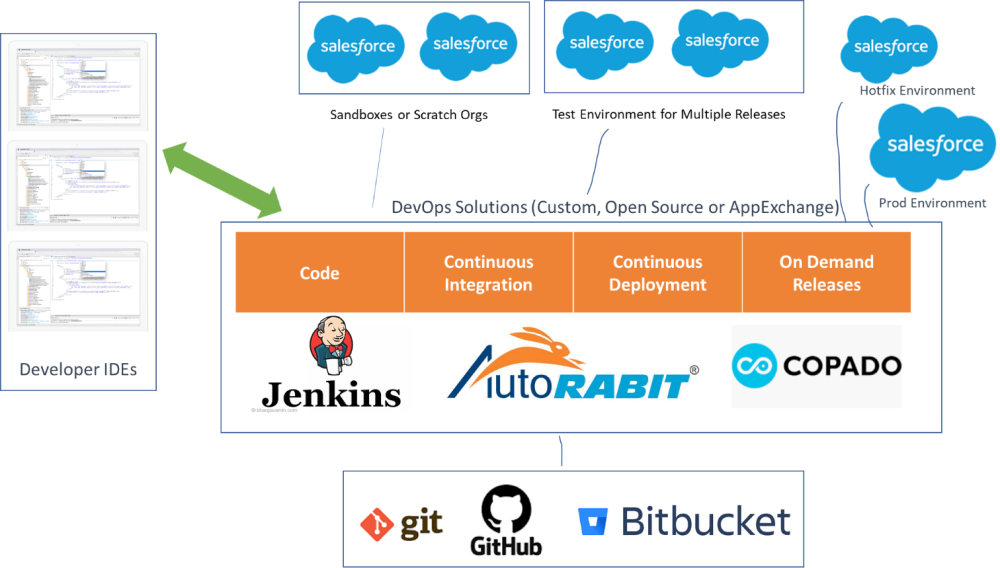Today’s users rely on the Salesforce platform for sales, marketing, billing, analytics, customer support, and several other functions. Powerful features and the ability for deep customization make Salesforce 2022 the preferred platform to unlock efficiencies and drive competitive advantage.
However, leveraging the power of Salesforce 2022 needs planning. Today’s complex orgs need customization, which requires advanced programming skills. Side-by-side, business pressures force developers to seek faster ways of application delivery.
Enter Salesforce DevOps. Salesforce DevOps makes it easy for Salesforce developers to roll out changes and make customization seamless.
DevOps is an approach to software development that enables high-speed delivery of applications and services. The enterprise adopts the right mix of tools, procedures, processes, and techniques to execute code efficiently and speed up things without compromising quality or reliability. The best tool depends on the specific nature of the business and the ecosystem.
Here is a diagram which depicts the Salesforce DevOps workflow:

Source: https://www.mirketa.com/salesforce-devops-continuous-integration-deployment/
Salesforce Developer Experience, launched in 2016, brought out extensive tools to support the
software development lifecycle. But with the ecosystem becoming more and more complex and the cloud coming into play big time, these tools have become inadequate. Salesforce DevOps is now the preferred way to leverage scarce resources most optimally. Using Salesforce DevOps ensures the development teams perform efficiently and manage application delivery pipelines faster.
Salesforce DevOps adds value through the following ways.
1. Improved efficiency for complex deployments
Deploying changes for a single environment is easy using change sets, Salesforce’s native feature. Developers may add the different components one by one. But the process is manual and invariably error-prone and time-consuming. For instance, developers have to recreate or clone change sets each time when moving to an unfamiliar environment. They have to recreate the change set for every move from Dev to QA and then again for moving from QA to Prod. The manual effort and the time lag soon attain critical mass, and delay deployment. The limited feature sets supported by change sets make it unsuitable for complex deployments.
The latest Salesforce CPQ deployments include data pack configurations and metadata, with the metadata-driven by complex relationships between objects. Most Salesforce deployments now include managing data ingestion and off-platform configuration databases. Many projects co-opt advanced platforms such as Slack and Salesforce Customer 360. All these increase the integration challenge for developers. The deep customization mandated by business or customer further increases the complexity of the org.
- For Salesforce 2022 application development and deployments, DevOps improve efficiency. Automated processes spare development team from repeated manual work, and makes roll out of components instantaneous.
- DevOps support the full range of functionality. For instance, change sets do not support complex components, such as standard picklist values or sales processes. But DevOps support these features. DevOps enable deploying even the latest functions and feature sets with ease.
- Salesforce DevOps automation comes with micro services-oriented architecture and new software development methodologies. Automation tools embrace best practices to manage business ambiguity and complexity.
- Salesforce 2022 offers easy access to high-quality DevOps tools that simplify code development and execution. High power tools eliminate repetitive and manual operations in the software development life cycle, simplifying deployment. Releases become lightning-fast and do not disrupt incumbent workflows.
- Reviewing code and configuration is critical to ensure smooth deployment. Code scanning tools automate the manual process of reviewing code. These tools ensure that all team members in a spread-out development team follow the same code standards and best practices.
DevOps offers a tremendous upgrade from the old workflows. It allows developers to comply with code standards and follow best practices, leading to clean code with minimal technical debt.
2. Unlocking Value
In Salesforce 2022, developers use DevOps automation for:
- Optimal use of human resources. With Salesforce DevOps automating routine tasks, manual support becomes minimal to perform several tasks. The workforce may spend their time and energy on high-value tasks. Reducing human errors also improves accuracy and reduces discrepancies.
- Better collaboration options. DevOps automation energizes cross-functional teams. The complex nature of today’s deployment often leads to a large development team, where multiple developers work across multiple sandboxes. Also, competitive pressures force matrix teams, where developers work in tandem with business teams. The line between development and business teams is blurring fast. DevOps automation makes collaboration seamless for such big and spread-out teams. Automation makes intra-team communication, reporting, and compliance friction-free.
- Eradication of silos and minimizing inter-dependencies. The development team may focus on regular releases instead of wasting time and energy on troubleshooting.
- Get swift feedback. Swift feedback leads to better iterations and improves user experiences. Prompt identification of issues enables quick risk mitigation. DevOps tools trigger alerts when the algorithm recognizes an error. The automated system creates an early warning system, enabling the development team to intervene and make changes quickly and pre-empt the damage.

3. Agility
In 2022, Salesforce developers are increasingly using DevOps to adopt agile management techniques. Agile development approaches enable developers to make changes quickly and roll out deployments much faster.
Several tools offered by independent vendors deliver application lifecycle management for Salesforce app production teams. Such tools will gain increased attention in 2022. Salesforce DevOps Center will also feature work item management, furthering the cause of agile development.
A key ingredient of agility is measuring progress and making quick course corrections. DevOps metrics measure the value of the system. Technical metrics help find out project quality and compare performance with the set baselines. Economic metrics make it easy for the finance team to estimate the ROI of their interventions when taking decisions. Developers may use these metrics to measure the progress and impact of each iteration or improvement and make rapid changes if values are not up to the mark.
DevOps Research and Assessment (DORA), a standards group, has established four critical metrics for measuring DevOps activities. These metrics include change lead time, deployment frequency, mean-time to resolution, and change failure rate. These metrics provide baseline indicators for development teams. For instance, the development team may collaborate with the business team to devise strategies and plans to increase the deployment frequency. They may also draw up plans to reduce the mean time to resolution. In 2022, Salesforce DevOps platform vendors will integrate the four DORA metrics with value stream mapping to further the cause of agile development.
4. Co-opting Artificial Intelligence Operations (AIOps) to Salesforce 2022
AIOps enables developers to decide which data is important and which to discard. The AIOps engine takes care of data processing, leaving developers free to focus on deployment. Kubernetes remove the technical roadblocks of implementing AIOps in a DevOps environment. Any engineer from the development or operations team may quickly deploy Kubernetes and run Salesforce DevOps workloads.
AIOps also give enterprise systems self-healing features that save the time used for error detection.
5. Improved Reliability
A huge share of Salesforce 2022 users adopt DevOps to make their Salesforce implementation more reliable.
Full transparency: Salesforce DevOps offers complete transparency. Conventional deployment tools, such as change sets, are stand alone and do not integrate with change sets. Lack of integration creates a blind spot in multi-environment deployments and prevents developers from monitoring changes between environments.
Most Salesforce DevOps development tools come with extensive feature sets that simplify deploying and managing changes. Developers may access these features easily through intuitive user interfaces. The basic features available through most DevOps deployment tools include:
- Version Control: Seamless integration with hosting providers such as GitHub offers complete visibility into changes. The DevOps Centre in Salesforce DX gives a robust audit trail that allows admins and developers to track changes between orgs and apply version control when deploying changes in environments.
- Continuous Integration (CI) / Continuous Development (CD): CI/CD tools create automated delivery pipelines for all sandboxes. DevOps delivers increased release cadence from automation (CI/CD), leading to a tighter feedback loop.
- Reporting: Flexible and automated reports on the deployments. Reports make it possible to monitor and adjust team performance. Automated DevOps offer constant updates, improving reliability.
Salesforce’s new extensions for Visual Studio Code connect development orgs to an intuitive code editor, making the process more robust. Salesforce DX CLO, Salesforce’s powerful command-line interface, offer commands to move metadata between orgs and create scratch orgs.
6. Test Automation
Test automation enables deeper and faster testing, improving user experience and the reliability of the process.
To ensure robust end-to-end functionality, Salesforce developers run several tests, including unit tests and screen-based tests. Extensive testing enables early identification of likely issues, ensuring the continuous release of Salesforce applications. Running tests during the DevOps cycle ensures the changes do not lead to unexpected errors in the target Salesforce org.
DevOps tools automate unit tests, taking the load off developers. These second-generation tests run on set schedules, on the Salesforce instance. Unit tests run in the org and ensure Apex classes do not fail.
Such second-generation testing will grow in 2022.
7. Improved Backups
Salesforce has discontinued providing data recovery services. Therefore, backing up Salesforce CRM and metadata becomes more important than ever before. Instances of overwriting a complex flow or Apex trigger are all too common. The hard way of backup in Salesforce is by juggling the various CSVs.
The DevOps approach enable metadata backup, with the option of rollbacks. The ability to rollback changes that do not work as expected reduces risks. Using the rollback feature with DevOps ensures users go through minimal disruption, regardless of the changes in the deployment instances.
The easy way of taking DevOps backups is by using any of the many specialized backup apps. These apps provide neat and straightforward user interfaces that make it easy to restore data at any point in time.
8. Cloud Adoption and Security
The Salesforce DevOps ecosystem is also becoming increasingly cloud-native. Cloud-based DevOps solutions enable better security.
Releasing updates quickly is critical for security teams to remain one-up against cyber attackers. For instance, the recent Log4J vulnerability has raised the stakes of application security. Log4j is a popular open-source software that functions as a logging library for Java. The Log4j vulnerability enables malicious attackers to execute code remotely on any targeted computer. DevOps allow developers to apply the relevant safeguards and also upgrade the code at lightning fast speeds, on detecting vulnerabilities.
DevSecOps (Development, Security, Operations) methodologies complement serverless, cloud-native technologies, further boosting enhance security. In Salesforce 2022, DevSecOps will encompass the enterprise’s entire supply chain to pre-empt attacks through a weak node in the supply chain.
9. Better Instrumentality
Instrumentality in DevOps entails installing a signalling code that records a log entry when invoked. Most times, the log records performance data from an application. Integrated analytics tools review the raw performance data.
Salesforce has instrumentation capabilities in-built for system-wide exceptions such as Apex error messages. But higher-level application activity metrics are not in-built and require coding. DevOps makes the task easy.
In 2022, Salesforce’s new Performance Assistant and Scale Center will enhance instrumentation capabilities. Cloud-native observability and application performance monitoring capabilities will expand the scope of instrumentation. Most third-party and independent platforms offering such functionality will integrate seamlessly to Salesforce by 2022.

10. Better Compliance
One reason for the increased popularity of Salesforce DevOps platforms in 2022 is to address increased regulatory demands.
Enterprises come under increasing pressure to comply with SOX and other regulatory requirements. SOX compliance is incredibly complex, as the enterprise has to document the stability and cybersecurity of IT systems that handle vital company data. In such a situation, Salesforce increasingly becomes a system of record. Developers increasingly look at DevOps to find solutions for such complex demands.
DevOps makes compliance easy by:
- Enabling a “compliance culture” by promoting transparency and improving inter-team dynamics. The approach allows for the free flow of information. Development teams may pinpoint trouble spots easily and make prompt amends.
- Automating specific processes to make the system effective, unbiased, and reliable.
- Improving communication and collaboration, to make compliance reporting function on auto-pilot.
Salesforce DevOps is on a growth spree. In 2020, Salesforce DevOps companies attracted equity investments worth $38.5 million. In 2021, this figure became $275.5 million, a seven-fold increase. There were several high-profile business deals in the space as well. AutoRABIT acquired Codescan. Copado, one of the most significant players providing Salesforce DevOps applications, acquired New Context and Qentinel. Opera started collaborating with HashiCorp Vault, and Copado integrated with the DigitSec S4 cybersecurity platform in the vendor distribution and integration space.
Salesforce 2022 is thus becoming the gold standard for digital transformation. Salesforce DevOps makes the task easy, fast, reliable, and cost-effective.




